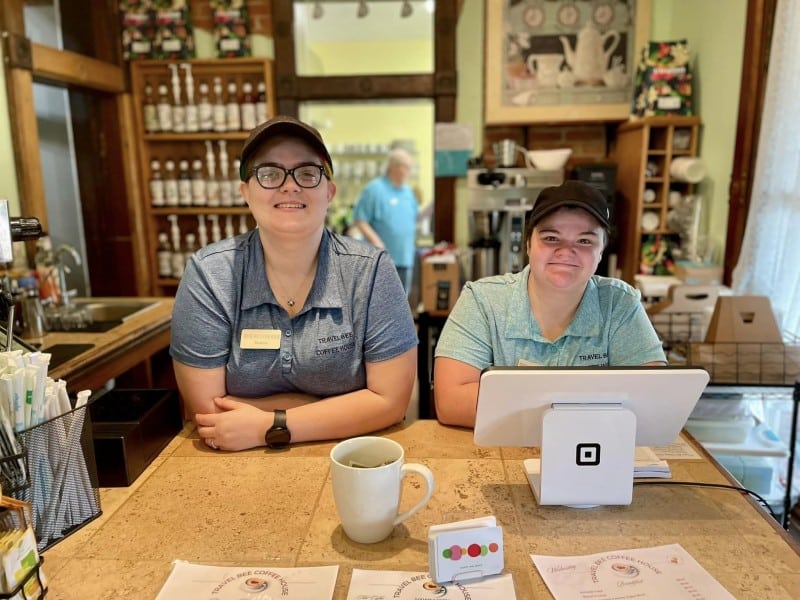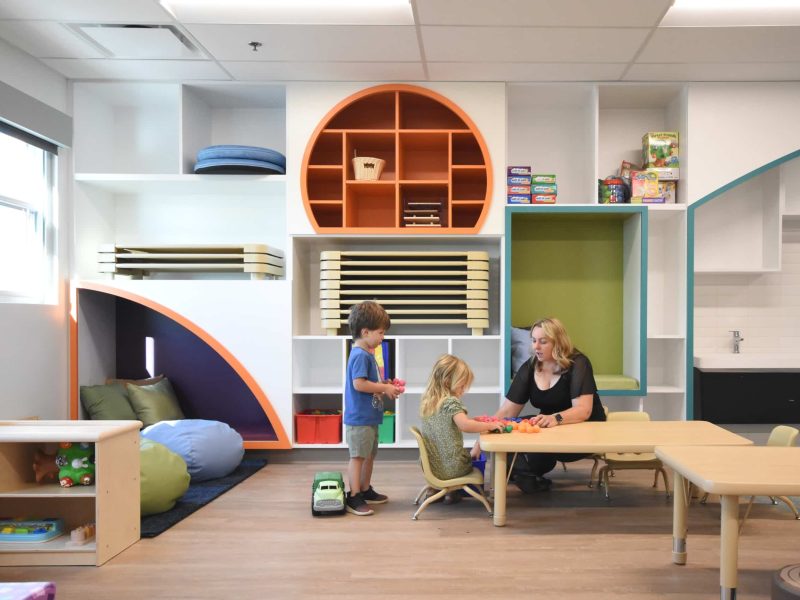Demolishing hope: How the fight to save Ward School became the fight to stabilize a neighborhood
“How do you destroy a community? There are several ways you do that.”
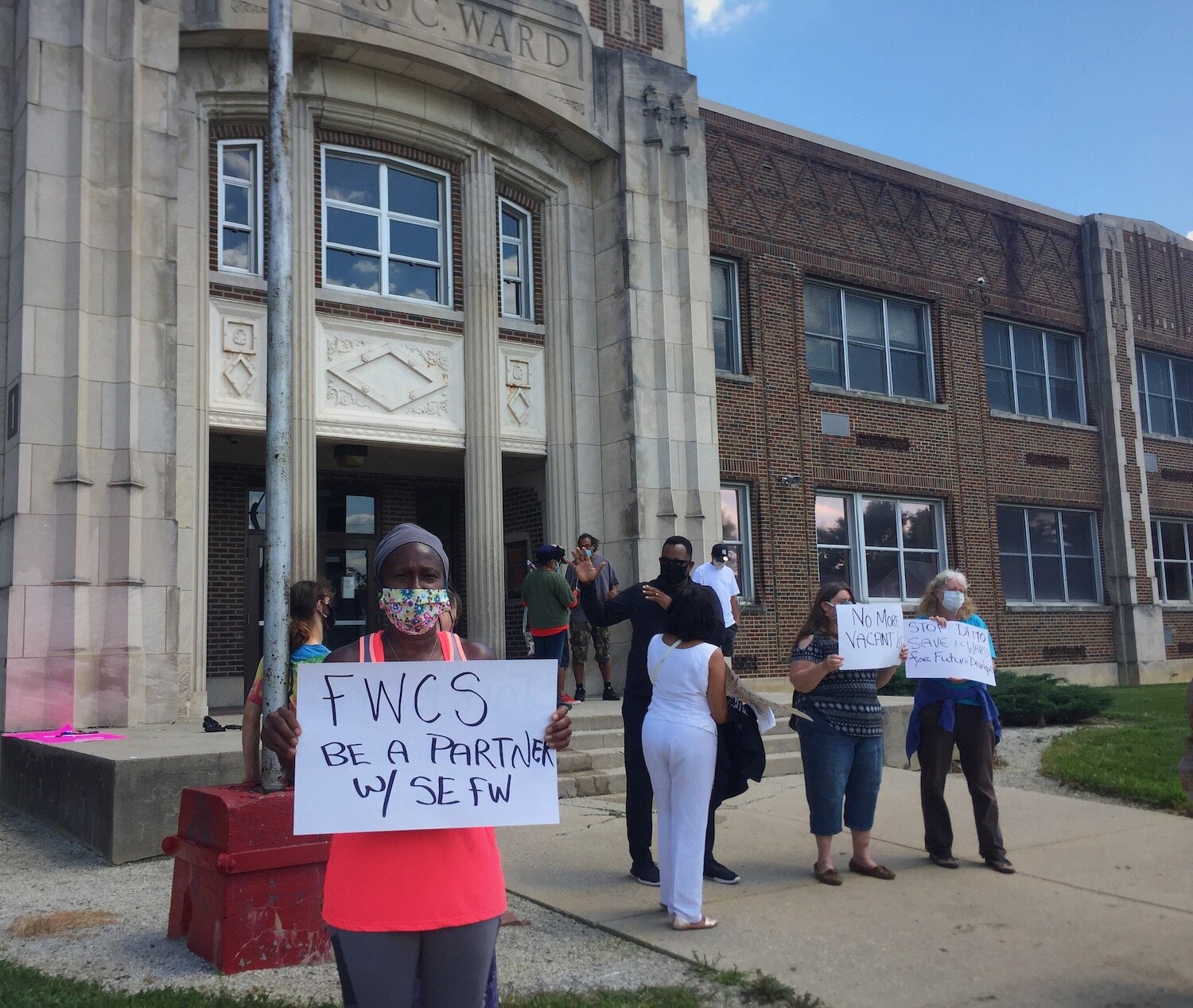
“Save Ward School. Save Ward School. Save Ward School.”
The voices of about two dozen neighborhood protesters chanted in unison on Friday, Aug. 7, 2020, atop the regal front steps of L.C. Ward Education Center (formerly Lewis C. Ward Elementary School) at the corner of Warsaw and Oxford Streets.
On the surface, it’s a fight to preserve a vacant school building in Southeast Fort Wayne from impending demolition.
According to ARCH Inc., the school is a 1931 Tudor-revival style building designed by Fort Wayne architect, Leighton Bowers, and it’s “a case study for those wanting to learn about a wide variety of elaborate brick patterns,” featuring zigzag, chevron, and sawtooth designs.
“Look at the detail by the door and the detail in the brick,” says Connie Zuber, Executive Director of ARCH who showed up at the protest with flyers about the organization’s historic preservation work. “The cool thing is, you go around back of this building, and even that’s beautiful. It’s not like a movie set that only looks good on the front.”

But beneath the surface of a fight to protect a glorious historic building, currently owned by Fort Wayne Community Schools (FWCS), is the war to preserve a pillar of stability in a transient neighborhood and give an underserved community the opportunity to dream.
Diane Rogers, wearing a bright orange tank top and a warm smile, is one powerhouse behind Friday’s protest. As Vice President of the Oxford Neighborhood Association, known for her African drumming and dance classes called the Omotayo Rite of Passage, Rogers says everything she does to support her community boils down to one simple goal.
“It’s to empower people to a more conscious way of thinking about growth, protection, and legacy,” she says.

Rogers has stayed true to these values throughout her life and career. She’s now technically retired after spending 27 years working for the Fort Wayne Police Department as a liaison officer in the Oxford neighborhood. Amidst the rise of the global Black Lives Matter movement and tense conversations about police brutality, Rogers finds herself in a unique position, processing everything as both a Black woman and a former officer. She says she believes in the power of community-based policing that is knowledgeable of the people and neighborhoods it serves, and she strives to uphold these values in her retirement work in the Oxford area. She sees the fight to preserve Ward School as an extension of her mission to protect the neighborhood by focusing on systemic factors that influence crime-challenged places, like stability, access to resources, and investment.
“I’m a homeowner here, and we have a 35 percent home-ownership rate in the Oxford neighborhood and a 65 percent rental property rate,” she says. “That’s not a good balance. It does not stabilize a community when we’re constantly having new tenants.”
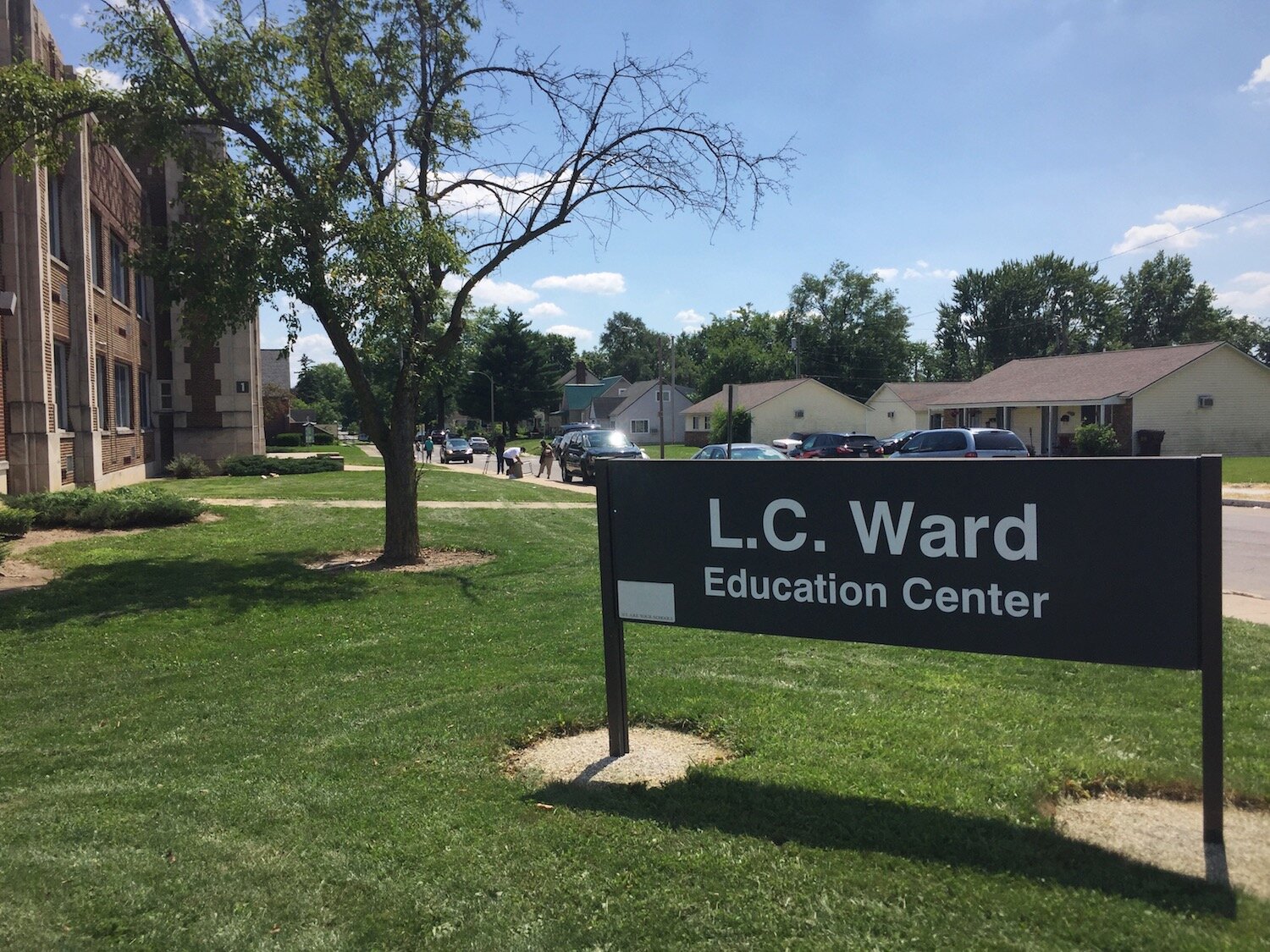
Tearing down a neighborhood pillar, like Ward School, would only exacerbate the area’s instability, Rogers believes. She also thinks it would take away a critical opportunity for the community to redevelop a beautiful, historic space and bring more unique businesses and organizations to the Southeast side.
“It is so needed for us to have resources for education and development here,” she says. “Every other community in Fort Wayne has resources? Why can’t we develop and create a conscious community that leaves a legacy for the next generation behind us? It’s just that simple.”
***
A need for more resources on the Southeast side is the same reason that’s driving 6th-district City Councilwoman Sharon Tucker to fight to preserve Ward School.
Tucker has lived on the Southeast side for more than 45 years. She grew up a half-mile away from Ward Elementary School, and she remembers walking there for kindergarten through second grade. But today, she says there are not many resources and amenities that people in Southeast Fort Wayne can walk to from their homes—which is challenging because many residents do not own personal vehicles.
Instead, the 46803 and 46806 zip codes are oversaturated with low income and tax credit housing projects, which create a concentration of poverty in the Southeast quadrant.
Tucker fears that if Ward School is torn down, its land will be used for another affordable housing project, which will reap big returns on investment for its developers, but only perpetuate poverty in the neighborhood. While she sees the need for more affordable housing in Fort Wayne, she also thinks it needs to be better distributed throughout the city.
Instead of a housing project only, she’d like to see Ward School used as a mixed-use redevelopment project with amenities like a recreational center, a gym, a community kitchen, and a health clinic on the first floor and affordable housing on the second level.
“I personally believe that building has the opportunity to be multiple items for the community,” she says.
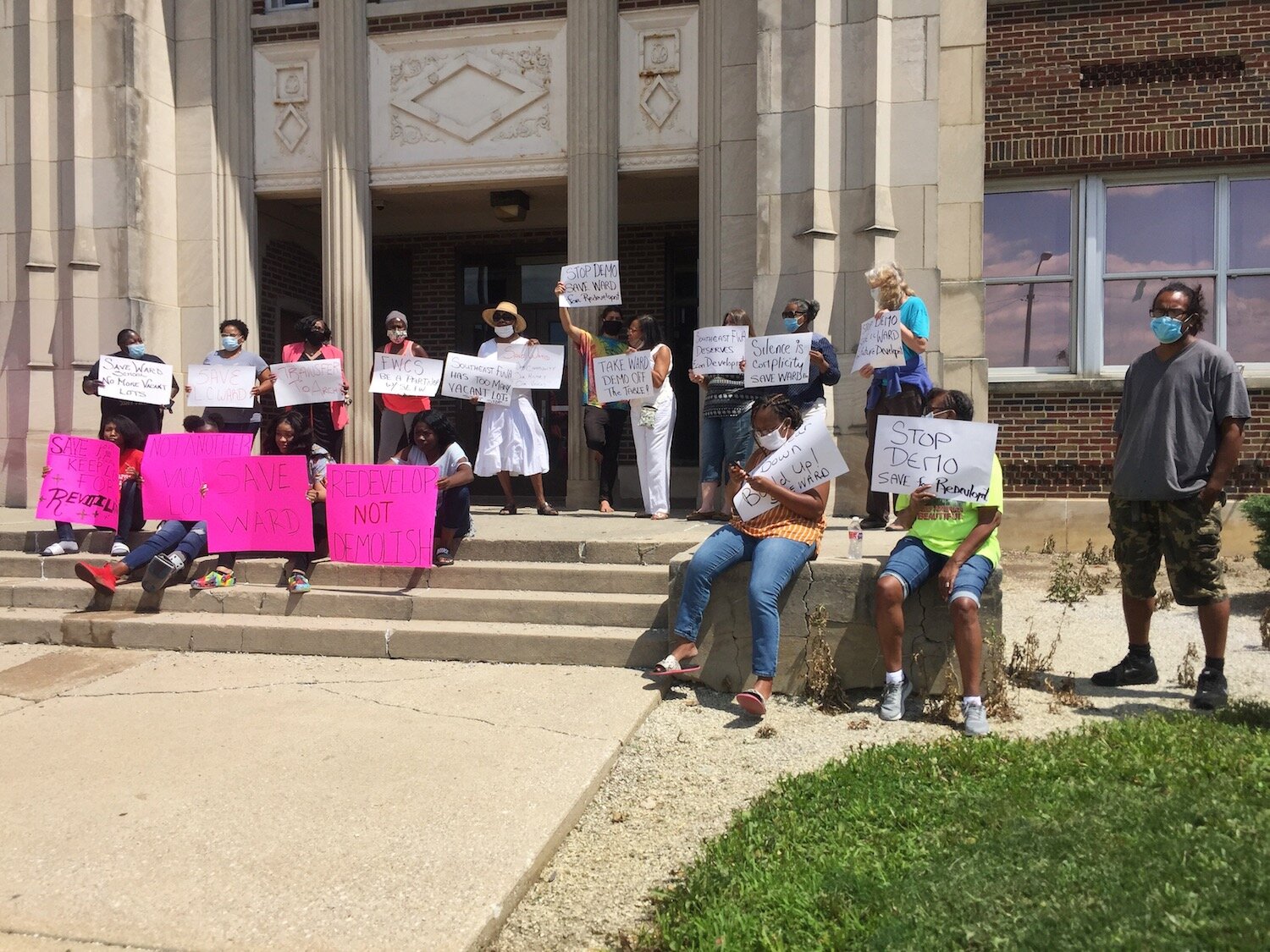
She also thinks Ward School could be useful to the City’s SEED Fort Wayne programs, like Build Institute and Summit City Match, which help minority entrepreneurs launch businesses and occupy historic storefronts, currently near downtown on S. Calhoun Street.
“When people graduate from the SEED programs and want to keep their businesses Southeast, there’s no place for them to go,” Tucker says. “Most of that is because all of the older stock, brick buildings here have been taken down for one reason or another.”
Unfortunately, the loss of historic redevelopment opportunities in low-income neighborhoods and communities of color is not a new story across the U.S., says Rogers.
She notes that the Southeast side of town was a formerly redlined district. As a result, she feels that it mirrors other communities of color, which have seen less adaptive reuse and more demolition of their historic structures than white-dominant parts of their cities.
Getting rid of buildings that are good candidates for redevelopment disincentives entrepreneurs and investors from taking on projects in certain parts of town, Tucker says. She sees the plan to demolish Ward School as another barrier to advancement in Southeast. Now, it’s time for residents to stand up and speak out.
“How do you destroy a community? There are several ways you do that,” Tucker says. “The onus is on us as residents and civic leaders to speak truth to power, and say, ‘We see what’s going on, and even if you do that, you’re not going to do it as comfortably as you have in the past.’”
As a City Councilwoman and a resident in the area, Tucker says she didn’t know about FWCS’s plans to demolish the Ward School building until late-March.
“We did not know they were thinking about taking down that building,” she says.
Now, community members like Rogers are asking for the district to give them a chance to find a benevolent developer who sees Ward School as the jewel they believe it can be.
“I’m just saying that we have a building of this magnitude here, and it still has some life in it,” Rogers says.

As someone who has recently toured the building with ARCH, Zuber confirms that Ward School does, in fact, have a lot of life left in it.
“The stewardship of this building has been excellent,” Zuber says. “It’s an excellent candidate for reuse.”
At the same time, she understands what FWCS is up against, owning a large, historic building and not having the resources to take on an adaptive reuse project themselves, particularly during a pandemic.
“It’s not an easy position,” she says.
For the past few weeks, Zuber has been working with leaders of the school district behind the scenes to buy more time for the building to be saved and repurposed. Thanks to her efforts, as well as a letter from Councilwoman Tucker, the FWCS School Board took Ward School off its agenda for Monday’s meeting and delayed the decision until later this month.
WANE TV reports that Fort Wayne Community Schools closed Ward Education Center in 2017 and moved the district’s alternative learning program there to a newer building.
“After sitting vacant for three years, FWCS investigated demolishing Ward,” a statement from FWCS says. “As concerns and interest have been raised about the building, those plans are currently on hold. FWCS officials will meet with community leaders, elected officials, and ARCH to discuss the building later this month.”
Zuber says that her team has been working with Indiana Landmarks to preserve the school, and they’re hoping to engage more people from the Oxford neighborhood to help determine what the space should become.
“All we need to do is find a way to make saving this building work for ARCH, for FWCS, and for the neighborhood that cares so much about it,” she says. “That has been done so many times across the state of Indiana, and I’m convinced we can find a way to do it here.”
For Oxford-area residents and business owners, making sure the building will be useful to its surrounding neighborhoods is key.
***
As the Executive Director of the Human Agriculture Co-Operative and owner of the developing Utopian Community Grocery on Oxford Street, Ty Simmons came to the protest on Friday to promote the interests of the neighborhood.
“We’re afraid there’s going to be another huge entity that comes in here and occupies the land,” Simmons says.
When it comes to redevelopment projects in Southeast Fort Wayne, he says there are often discussions about what can and should be done, but he feels that the people who live in the area aren’t usually invited to the table.
“How can you determine what’s going on if you’re not at the table?” he asks.
Simmons hopes that Ward School can be used as a training facility of some kind to teach young people in Southeast skills in construction, plumbing, or electric work that they can use to find gainful employment. He’s also working with Rowan Greene of Plowshares Cooperative Food Hub, to pitch a project of their own for the space: A food innovation center and community hub.
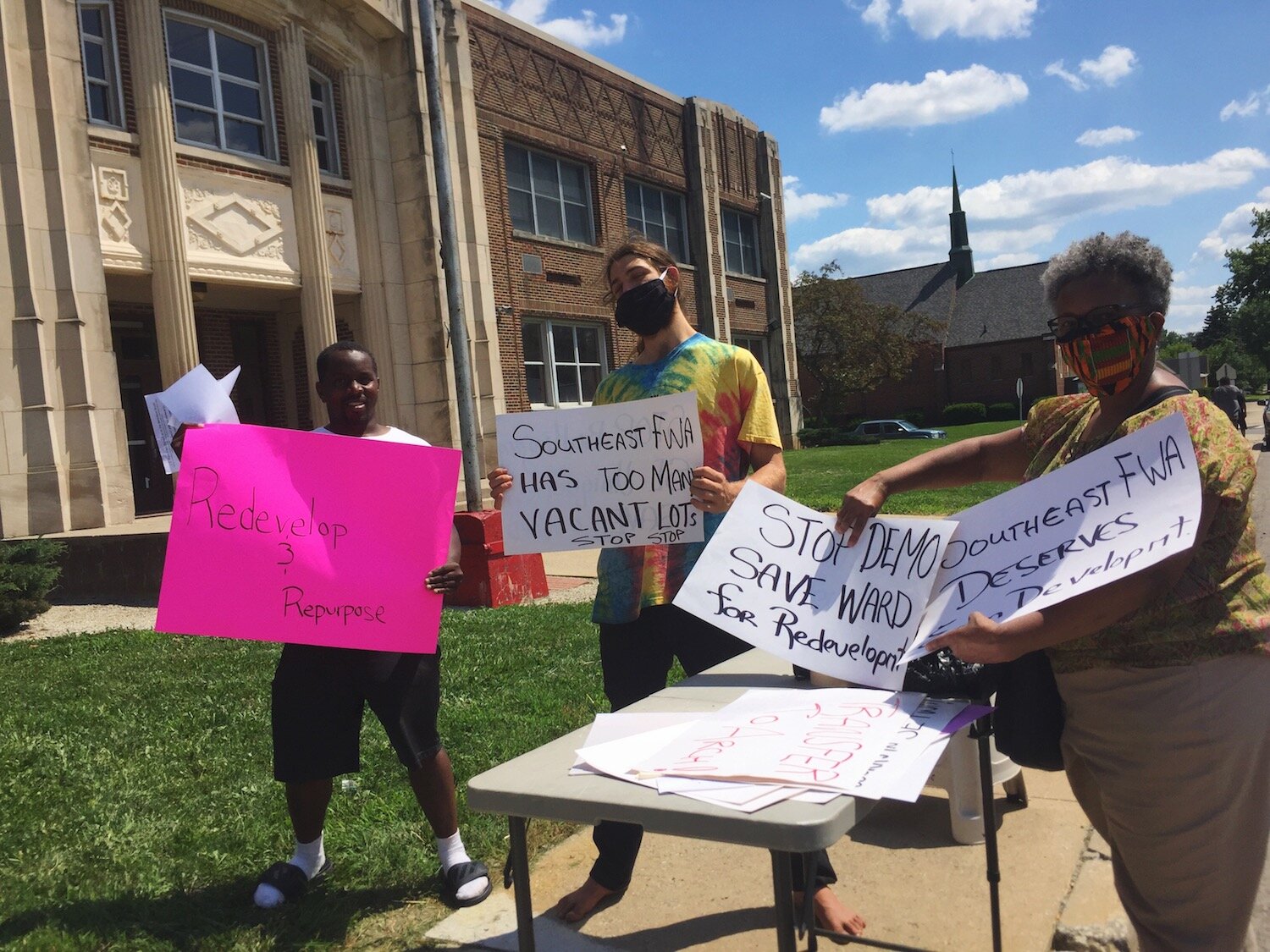
Greene, who also came out to Friday’s protest, says he was there to represent the business plan, which was originally given to him from Tim Ehlerding, the former Executive Director of Wells County Economic Development. Before Ehlerding left his position in 2015, he pitched the concept for a $5.5 million “game-changing” food innovation hub to the Regional Opportunities Council (ROC), originally proposed for Bluffton. The plan called for teaching members of the community how to create and scale food products that meet health safety standards.
Greene and Simmons hope to revive a version of this plan in Southeast.
”We would have food scientists that analyze their recipe and tell them what they need to do to make it shelf-stable and scalable,” Greene says. “The goal is putting equipment in Ward School, so that people could bring in raw materials, process their sauce or soup or whatever, all the way from raw materials. Then package it, label it, market it, put it on pallets, and ship it out nationally.”
Greene says that since it’s such a large project, it would require funding from the City and Redevelopment Commission to make it happen, so he’s been in conversations with them for the past nine months. But he feels like his efforts are being snubbed.
“I actually talked to the City and Commission about this last year,” Greene says. “They said they would get back to me. At the beginning of the COVID-19 pandemic, they said they had something exciting in the works, and they would get back to me. The next thing I know, it’s up for demolition.”
Cindy Joyner, Director of Community Development, says, “Community Development staff responded to requests from neighborhood residents to explore the redevelopment of Ward Elementary School and have had conversations with residents, ARCH, and Fort Wayne Community Schools. Community Development has not expressed support for any particular use of the school and recognizes Fort Wayne Community Schools’ need to determine what is in the best interest of the school system. Community Development would be willing to provide consultation to FWCS and also to ARCH or another entity should they want to take ownership of it.”
Tucker feels hopeful that if the building is turned over to ARCH, they will work with the Oxford community to determine an effective and authentic use of the space. Greene and Simmons say that more than anything, they just want to make sure Ward School is saved and that people from the neighborhood get to decide what it becomes.
After all, demolishing the school is likely to cost hundreds of thousands of dollars anyway, Simmons points out.
“Imagine what could happen if they gave that money to entities here instead and built something sustainable,” he says. “There’s just so much that could be done here.”


